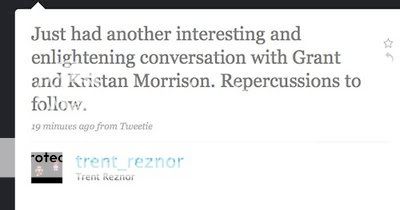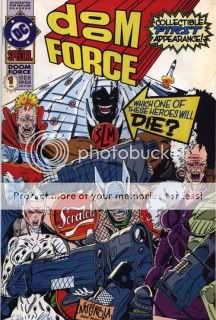
Wednesday Comics #1
Brian Azzarello, Eduardo Risso, Dave Gibbons, Ryan Sook, John Arcudi, Lee Bermejo, Dave Bullock, Vinton Heuck, Kurt Busiek, Joe Quinones, Neil Gaiman, Mike Allred, Eddie Berganza, Sean Galloway, Paul Pope, Jimmy Palmiotti, Amanda Conner, Dan DiDio, Jose Luis Garcia-Lopez, Kevin Nowlan, Ben Caldwell, Adam Kubert, Joe Kubert, Karl Kerschl, Brendan Fletcher, Walt Simonson, Brian Stelfreeze, Kyle Baker, writers/artists
DC, July 2009
16 pages
$3.99
No sense beating around the bush: I don’t like newsprint. It’s flimsy and icky and doesn’t look nice. It doesn’t hold color well. You get a big fold-out broadsheet made of newsprint like this thing and fold and unfold it a couple of times and it becomes more messed-up and harder to do anything with each time. I don’t like it when newspapers use it, I don’t like it when PictureBox uses it, I don’t like it when Paper Rodeo uses it, I didn’t like it when that Comic Shop News thing they’d stick in the bag with your weekly pull list used it (they still around?). To paraphrase James Murphy, I don’t get the borrowed nostalgia for the unremembered ’30s. I don’t like paying $3.99 for a comic that self-consciously evokes its own disposability with the stuff it’s printed on, either. (Hell, I don’t like paying for a single issue of anything.) Basically this project is designed, aesthetically, to press a lot of buttons I don’t have.
That said, Wednesday Comics #1 works perfectly well as a sort of My First Kramers, an astutely curated experiment in what happens when you tell a bunch of auteurs to do they thing on a gigantic canvas. As with Kramers Ergot 7, you get a few different approaches to how to use all that space. Some of the creative teams, most notably the father-son team of Joe and Adam Kubert, just blow up a regular grid, resulting in an eye-arresting sequence of Nazis playing the captured Sgt. Rock a chin-music symphony and giving you that “Lily Tomlin holding a giant book” sense of the object’s sheer size. Others cram the page with extra information: Ben Caldwell’s Wonder Woman strip, a far less nostalgia-inclined affair than most in the book, is riddled with tiny panels and minute twists and turns, while Karl Kerschl and Ben Fletcher’s Flash effort takes a cue from the likes of Dan Clowes and tells its story through a pair of self-contained but interconnected funnies-style strips. Other creators tip their hats to the newspaper strips of yore as well: Dave Gibbons and Ryan Sook’s Kamandi story is done Prince Valiant-style, while Paul Pope’s Adam Strange effort is a less direct but still recognizable homage to classic adventure strips and sci-fi pulps. Even the modern era earns some tips of the hat: Kurt Busiek and Joe Quinones’s Green Lantern strip references Darwyn Cooke’s New Frontier in era, tone, look, and even a mention of its title, while the awe-inspiring naturalist Kyle Baker Hawkman art that took the internet by storm is employed in the service of a disappointingly direct and unfunny 300 parody. (He’s riffing on that long opening sequence from the comic version–“We march.”–that Zack Snyder didn’t use in the movie, so maybe people will miss it. I’m kind of jealous of those people.)
When you print comics this big you have a lot of space to fill, which draws your attention to coloring even more than normal, and in this case that can be a blessing and a curse. Trish Mulvihill escapes the dreaded Vertigo Brown with some lovely golden hues in the Brian Azzarello/Eduardo Risso Batman piece that opens the issue, Ryan Sook provides some interesting purple-orange sunset scenes for his Kamandi strip, Joe Kubert’s palette on the Sgt. Rock piece is refreshingly and effectively subdued, and Jose Villarubia’s gray skintone for Adam Strange meshes with his purple jumpsuit and bright blue enemies for an effect that looks appropriately aged and weathered. But I think in most other cases, the paper stock betrays the color work. You can practically feel Amanda Conner’s Supergirl wanting to be a bright red, blue, and blonde, Laura Allred’s normally radiant work looks in her husband Mike’s Metamorpho strip like you’re looking at it through sunglasses, Sean Galloway’s Teen Titans art is dialed way down (those graytone or nonexistent backgrounds don’t help)…even the great Dave Stewart is undone with colors for Dave Bullock and Vinton Heuck’s Deadman strip that just don’t quite click.
As for the stories themselves, who can judge at this early stage? I suspect that for the most part, how you react to these meager one-page morsels at this stage in the game depends on your preexisting feelings about the characters and the contributors. (Spoiler alert–I’m excited about the Paul Pope strip!) I think Ben Caldwell’s Wonder Woman strip, which is so different both visually and narratively from what you’re used to seeing from DC with regards to this character–and from everything else in the comic–is the one that’s most likely to surprise in the long run, though for good or ill I don’t know. Also, clever of John Arcudi to open his Superman strip with Supes flying backwards at the audience, no? I do think it’s rather delightful that DC, or at least series editor Mark Chiarello, turned to a bunch of talented creators and told them to write about their respective characters in whichever way they chose rather than hewing to on-model continuity or overall vibe. (Hey, remember when Marvel did that more or less line-wide in 2000-2001 or so?) Of course, the thing about these kinds of non-continuity short-story “tone poems” in honor of this or that superhero character is that it’s hard to get them to stick, and harder still to get a sense of what you’ll get out of them in the end, other than “Hey, Metamorpho’s neat” or whatever.
That, I suppose, is the problem. Four bucks for 15 one-page slivers of story, 12 weeks in a row, is an awful big investment for an uncertain return. (And I’m already let down something awful by the Baker Hawkman thing.) This is why I think it’s fair to spend so much time kvetching about the paper stock, because Wednesday Comics isn’t a series, not really–it’s an object. The size, the format, and most especially the newsprint were selected to stand out, to impress the physicality of the object upon you. Seeing the burst of publicity for the book last week made it clear that this was a smart choice in some ways: Tying a high-profile comic book launch in this day and age to a way of doing comics that’s almost completely outmoded, with bonus points for resonating with the overall death of newspapers, was bound to attract the attention. Meanwhile, within the world of comics, this is the sort of project, and the sort of talent line-up, that’s bound to win plaudits from bloggers and award committees–if this thing doesn’t clean up at next year’s Eisner’s I’ll eat my hat. The point of Wednesday Comics is for you to note how different, how unique, how special it is. Which is well and good, but it’s all undercut if you just don’t like newsprint, you know?








